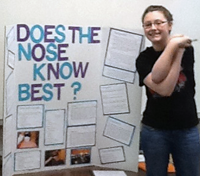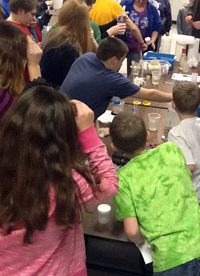Top Science Teacher Inspires Student Science with Science Buddies
For this middle school science teacher, Science Buddies has a front-row seat in the classroom, providing support for hands-on student science fair projects and for curricular and extra-curricular planning.

Students and Teachers Find Hands-on Science Success with Science Buddies
Angela McDaniel uses the Topic Selection Wizard and Project Library of more than 1,300 hands-on science, technology, engineering, and math (STEM) project ideas with her students in Moatsville, WV.
In recent years, Angela has had many students succeed with their Science Buddies projects, both in the classroom and at local and regional science fairs. (Pictured above: a former student with her project display board from the The Nose Knows Smell but How About Taste? human biology and health project.)
For Angela McDaniel, a recipient of the 2011 Presidential Award for Excellence in Mathematics and Science Teaching, and a teacher at Kasson Middle School in Moatsville, WV, Science Buddies is an indispensable resource in helping plan and prepare the school's annual Family Science Night and in supporting students in tackling robust projects for local and regional science fairs. Angela says she has been using Science Buddies for six years, both at her current school and at a previous school, and the site and its wealth of tools for both students and teachers have become an important part of her classroom.
Helping Students Find Perfect (for Them) Projects!
Angela teaches students in grades 5-8, and as her classes begin their journey to the yearly science fair, she spends several days of in-class time with the students on the Science Buddies website. Students are also given the opportunity to use the school's computer lab to browse Project Ideas and resources at Science Buddies.
Like many educators, Angela encourages her students to use the Topic Selection Wizard for assistance in finding a project that is of interest and that is also appropriate in terms of its level of complexity. "I love the grade and difficulty level rating," says Angela. "That way I can assign a student a level, but they still have plenty of choices!"
To help students (and teachers) locate appropriate science Project Ideas, Science Buddies labels each project in terms of its "difficulty." The label does not correlate directly to "grade level" because there are many variables that come into play when determining which projects are suitable for individual students. Not all sixth graders, for example, have the same academic background, skills, or experience, so a project that works for some sixth graders may be too complex (or not challenging enough) for others. The difficulty ranking system takes this into account and helps teachers, students, and parents match projects to a sliding scale of grade levels for which a project may be appropriate.
Angela says the difficulty ratings are particularly helpful because she can assign students different levels of Project Ideas to consider, and she often assigns a "minimum" difficulty ranking. "This works very well for the wide variety of students that I have (mentally impaired, learning disabled, gifted)," she explains. "It also is wonderful for the elementary teachers that I work with when they are looking for something to do with their classes or when I am assisting with our 3rd and 4th grade science fair!"
Inspiring Interest in Science
Dedicated to engaging as many students as possible during their hands-on science projects, Science Buddies believes having a wide range of projects is key to supporting hands-on science and to helping students enjoy their science, technology, engineering, and math (STEM) assignments—particularly important for students who do not naturally identify themselves as interested in science. With a growing library of more than 1,300 Project Ideas in more than 30 areas of science, Science Buddies has something for everyone, and the Topic Selection Wizard does a remarkable job in helping match students to projects of interest.
"There are so many topics covering so many disciplines that students are bound to find one they like," says Angela, noting that 85% of her students used a Science Buddies Project Idea for last year's school science fair. Many of her students go on to succeed in science fairs with their projects. At Kasson Middle School, all middle schoolers (grades 5-8) compete in the school science fair. Of the nine top projects at last year's school fair, six were based on Science Buddies projects. Seventh and eighth grade winners at the school science fair go on to the Eastern Regional Science Fair at Davis and Elkins College. Of the projects that progressed to the regional fair, six from Angela's school placed (won an award), four of which were based on Science Buddies Project Ideas.
"We have had great success with students and Science Buddies projects placing at both school and regional level," says Angela. "Students tell me that they like Science Buddies because they can get a whole idea for a project and find variations, as well, to help them make it their own!"

Getting the Whole Family Involved
Angela uses Science Buddies to help plan a yearly Family Science Night for parents and students. Many teachers organize such science nights to help parents better understand the role of hands-on science and to help set expectations for the year. (Pictured above: students and parents at one of Angela's family science night events.)
The following Science Buddies resources help educators in planning these events:
Emphasizing the Family Connection
In addition to using Science Buddies with her classes for their own projects, Angela turns to Science Buddies when planning activities for the yearly Family Science Night. Science nights vary from school to school. Some schools exhibit student science projects on Family Science Night. Other schools conceptualize the night differently. At Angela's school, Family Science Night is a precursor to the science fair, a family "kick-off" of sorts for the science fair season. "Our family night was set up to get parents and students 'in the mood' for science fair," explains Angela.
With parents and students gathered, Angela walks through the scientific method, explaining how students use the set of steps to approach testing and answering a science question. This year, she used Science Buddies' Bubble-ology Project Idea on Family Science Night. After introducing the project, and on the heels of refreshing attendees about the scientific method, they formulated a hypothesis for the experiment and then broke into groups to do the hands-on testing. Once everyone had completed the "lab" portion of the activity, they regrouped, says Angela, and talked about their findings and the importance of collecting accurate data and drawing conclusions.
Angela also uses Science Buddies with an eCYBERMISSION club she leads, a group that prepares science projects for submission in the U. S. Army's eCYBERMISSION online science fair (open to students in grades 6-9). This year, Angela had eight groups complete projects for eCYBERMISSION. Four of those based their projects on Science Buddies Project Ideas, and one of those teams placed first in the state.
The Changing Face of Science Education
Science, technology, engineering, and math (STEM) is a critical concern in today's school systems, a concern being underscored even more by the new Next Generation Science Standards (NGSS), which emphasize the importance of hands-on science and the inclusion of the engineering method in addition to the scientific method. Teachers like Angela are in the trenches trying to sort out and balance changing curriculum with available classroom time and resources, and Science Buddies is dedicated to helping provide quality tools and resources to assist teachers in meeting STEM needs in their K-12 classrooms.
For Angela, the importance of hands-on science and activity learning cannot be understated. "I think that it is essential to 'do science' as often as possible. Students learn that science is applicable to many aspects of life and that many things they do and take for granted every day are 'science experiments.' They also learn the valuable skill of working in a team on a project from inception to conclusion. This is not always a skill they get in other classes."
Students with energetic, excited, and supportive teachers like Angela are fortunate to be putting science and engineering concepts into practice and learning to see and make real-world connections.
Science Buddies is proud to be a key resource for Angela and her students!

Using Filters to Find Projects at Science Buddies
Science Buddies recently introduced new filters that let students more easily narrow down the list of Project Ideas when browsing the Science Buddies library. With the new filters, students can specify the level of difficulty of Project Ideas they wish to view, as well as other criteria, like the area of science or the length of time required for the project. Learn more at Finding a Fitting Hands-on Science Project Now Easier than Ever!.
Categories:
You Might Also Enjoy These Related Posts:
- Making Recycling Sorting Machines—STEM Success
- Mini Trebuchets and a NM MESA Challenge
- Helping Students Build Coding Skills with Drones and Self-Driving Cars
- Middle School Student Codes to Improve Life with Visual Impairment
- Student Science Project - Designing and Coding a Video Game to Help People with Alzheimer's
- Teacher Combines Computer Science and Engineering Design for Middle School Students - STEM Success Story
- A Mirror Maze Success Story
- Paper Roller Coasters and Energy Transformation: STEM Teacher Success Story









